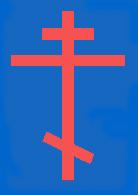

The origins of the Russian Orthodox Church’s symbol, that is the Cross that today is the Russian orthodox church’s cross, are difficult to trace. First, the Russian Orthodox cross doesn’t stem from Byzantium but from Rome. While the Greek cross is even both in vertical and in horizontal extension, the Latin cross’s vertical beam is longer than the horizontal. The Russian orthodox (the ”true believers“) maintain that the Latin or Roman cross must be the original as the crucifixion was a special Roman kind of execution.

Originally in Kiev a kind of Greek cross was used that can still be seen in the Sophia Cathedral in Kiev. Allegedly this cross was brought by Vladimir from Korsun (Khersones, on the Crimea), where he had been baptized. It is also called the Korsunian cross.


The two crosses presumably were used both during the time of the Mongolian yoke. The official cross was finally chosen with the reforms of Nikon that led to the schism within the Russian church, the ”raskol“ . Many of the Old Believers still use the Greek cross.Still, while in the Greek Orthodox Church the Greek cross is also the ground plan of the Church, while in the Catholic Church it is the Latin cross, the Russian churches are sometimes built on the base of the Greek cross, with a central dome and equal side ships, or they are square or rectangular, without side ships. They may be octagonal, with side ships, or square with half-round prolongations where the altar room is, behind the ikonostasis. The Russian cross evidently doesn’t serve as a ground plan.The smaller, upper beam is meant to represent the inscription on the cross which named Jesus’ crime: INRI, Jesus of Nazareth, king (Rex) of the Jews. The smaller, lower and inclined beam is assumed to have been a device to which his feet were nailed.
The lower beam is inclined because one end points to the repentant robber at his one side who will later be pardoned and ascend to heaven while the other on his other side who felt no remorse will be condemned to hell.